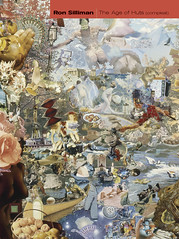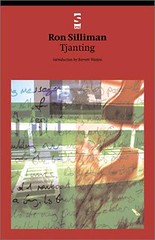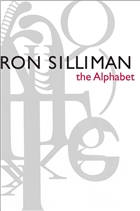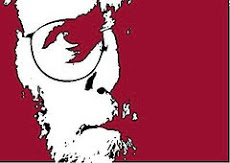The cover is felt. The binding is one large rubber band. The page would be square except that it’s not four-sided at all, with a substantial diagonal notch taken off the upper outside corner. To reinforce the idea that that notch is not accidental, authors’ names are printed along it inside. Finally, the cover has no title to speak of – but rather a large number 9 over which is printed:
becomes
impossibly,
stupidly
hard
This can only be Six by Six, No. 9 – not, profoundly not, to be confused with Philly’s own former 6ix. The theory of Six by Six is that six poets will have six pages each – six poems for some, fewer for others. As if to tease us poor readers, the pages themselves would have been seven inches by seven inches were it not for that notch, Notchka.
This time around, the six poets are Erica Weitzman, Jon Cone, Dorothea Lasky, Phil Cordelli, Julie Ritter & Laura Sims. A couple of these are names I’ve seen before, but I can’t say that I’m familiar with the poetry of any of them. Do they all come, as does the magazine, from the great borough of
The poet who actually got me to sit down & read this publication more closely was, as it happened, the last, Sims. I was flipping through & my eye landed on “
“Girl Walks Home Over Water”
Under whose gaze, in what desert, etc.
*
She is glistening plain.
Lovely, returning her dead
In the spotless car
That completely got my attention. I had to sit down & read all of her work, all of which come from a series called Practice, Restraint, several of which are numbered pieces entitled “Bank.” Here is “Bank Fifteen”:
In every backyard
A peacock
Or some green nonsense
Refuting
What rifles report from her far-flung states
Also really worth noting is “Bank Seventeen”:
At the east branch –
one empty room
And another
Abandoned
By Spaniards
There is a spareness to these poems that does not, as a result, surrender anything in its ability to reach beyond the obvious or referential. There is also, as I think all three of these samples demonstrate, a wry, shaded wit that is just a pleasure to read.
Flipping backward, I come across a poem by Jon Cone whose title is a delicious send-up of the dry Midwestern surrealism that was practiced at one moment in history by Robert Bly & James Wright (& more recently as maudlin farce by Franz Wright): “Thinking of Chekov on a Snowy Day in Iowa City, Iowa.” The poem that follows, tho, isn’t strictly parody – it hovers on becoming a tart homage. My favorite piece by Cone is the poem that comes immediately in front of this, “Figuring”:
I got seven today, yesterday I got three and the day before it was five.
I think it was five, or maybe it was two. It was two, for sure.
A guy I know married a chick with a face like a saint she had fourteen
in one day. Fourteen! And then get this she had seventeen the next and
thirty-one three days later. But now she manages one or two a day.
They divorced.
My uncle would get seven every day for nearly all his adult life,
but that was forty years ago. He’s dead. Died of cancer of the brain.
My brother usually does good, ten or eleven. Like everyone else
he has his bad days: one or two.
I pray sometimes. How phosphorescent it would be if I could get
seventy-seven in two days or one hundred and ten over three days.
But I know it won’t happen. It just won’t.
I don’t remember what my mother got.
I know my father never got much
even on the best day of his life.
This poem is a demonstration of how the absent referent can torque a poem right up. It reminds me of the importance, once again, of the lost or hidden, something Robert Duncan has had me thinking about all week. It’s the same principle, really, that gives Sims’ ”Spaniards” its twist above as well. If Cone rushes into this space head on, Erica Weitzman (a Brooklynite, I believe, as well as a grad student at the
becomes impossibly, stupidly hard
skin of the thighs, like a bitch hunger
this is what I am for, it says
the black space around that describes the un-
what. Derneath. Derstood. Speakable, saying, we have come
a long way just to come back again
and evade as quickly. I’d like, now
to shoot an arrow through something’s heart please
quivering, the quarry
it also
As should be apparent here, the poems of Six by Six don’t fit any uniform aesthetic stance. Phil Cordelli’s poems echo a stance that would be somewhere between late second-gen projectivism (think Jim Koller, Harvey Bialy, Chuck Stein, early George Quasha) & the Oppen side of Objectivism. Yet it is Julie Ritter who practices the finely balanced, exact free verse line. And Dorothea Lasky’s “Red Rose Girls” may allude directly to the modernists, but it sounds almost Beat in its rhythms & with its use of a thematic image, invoked in the first line of each section.
With a literal rubber band for its binding, Six by Six is not designed for mass distribution, nor for that matter for a long life on any bookshelf. To subscribe – or to check out any of Ugly Duckling’s other projects – link over to www.uglyducklingpresse.org.





